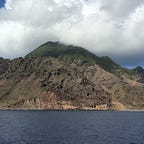Typee: a tale of contemplation, idleness, and cannibalism
Typee (1846)- Herman Melville (409 pages by my edition)
Before venturing into the story of Typee itself I want to give a little background. I specifically wanted to read this novel as it was Herman Melville’s first and most popular work during his lifetime. Moby-Dick although very popular and famous today was not nearly the success if you could consider it a success at all, as Typee during Melville’s lifetime. This story is roughly based on Melville’s own experiences in the South Pacific Marquesas Islands.
Typee involves a sailor by the name of Tommo who lands on the Marquesas Islands aboard a whaling ship. Tired of whaling life and a troublesome crew he leaves the ship with Toby, a fellow sailor. Even though the tribes of these islands are known to hold cannibals, the duo escapes the ship and plans to find refuge in the island’s interior until their whaling ship leaves. This plan goes awry and the duo is forced to make contact with a native tribe, eventually escaping separately much later.
The plot and word choice in this work are relatively simple. A large portion of the story surrounds the simple, pristine, idle nature of the Typee people and Melville’s diction seems to follow their lead. Very few of his passages are difficult to read or understand, sometimes he uses some terms not used in Modern English but these are few and far between. Occasionally, there are scenes of complex imagery as Melville attempts to convey to the reader some strange tribal custom or pristine piece of nature but again these verbose passages do not happen too often.
There are a number of key themes in Typee that run throughout the novel, as in previous reviews I will focus on a couple: namely othering, idleness, and simplicity. Tommo for more than half of the book is with the Typee tribe, treated well, fed, and given shelter but make no mistake he is alone. Tommo is unable to communicate with the tribe well and although given some level of freedom he understands he is a prisoner. This creates major psychological issues for Tommo as he feels isolated and separated from everything he ever knew. Tommo longs for conversation and longs for people, at the beginning of the work Tommo runs from the whaling ship and as the book leads on he would likely now run right back to it.
The idleness and simplicity of the Typee are central to a large part of the work. The Typee sleep for large portions of the day, are fed by a great number of coconuts and breadfruit that grow year-round, and overall perform very few necessary tasks on a day-to-day basis. Tommo often contrasts their idleness and incredible happiness with the materiality of the civilized cultures. Civilized cultures bound by materiality and money are much less happy than these supposedly uncivilized tribesmen. Tommo exalts the Typee greatly for their simplicity but also suggests that this tribe has almost devolved in some ways. Throughout the valley, there are traces of a great civilization with great stone works riddled amongst the tribal huts. These artifacts still form the foundation of many of the Typee’s current structures while other artifacts have fallen into ruin. Have the Typee become too idle and devolved or is idleness the source of their strength and happiness? Tommo and Melville seem to present findings to support both sides.
I found myself enjoying but wishing for more out of Typee. Much like Twenty Thousand Leagues Under the Sea, you begin the novel with a few questions and end the novel with a thousand questions. I found myself wanting more detail about the intricacies of the Typee culture or simply why Tommo was a prisoner yet treated with great respect and honors. Very few of these questions are answered. Melville provides incredible descriptions of the opulence of this valley and the pristine nature of its people, providing a wealth of information on the culture yet creating just as many questions.
As stated above, I enjoyed the work but felt that it fell short. I might have set my expectations for Typee too high believing that it might be able to surpass Moby-Dick since it certainly did during Melville’s lifetime. Typee like Moby-Dick provides great scenes of contemplation and beauty but unlike Moby-Dick that also shows tragedy and horrors, Typee really only hints at the horrors. I think the contrast that Moby-Dick provides is crucial to the story, a contrast that Typee doesn’t have.
As always, my scoring breakdown is below. Thanks for reading!
Score: 6.7/10- A beautiful tale of contemplation in an almost ideal state of nature but one that left me grasping for answers and action.
Readability: 8- Easy to read with great imagery although some scenes can be a little tedious.
Thematic Questions: 7- Melville provides a great commentary between the happy, idle ways of the Typee to the materiality of the civilized world.
Enjoyment: 5- Some interesting scenes on the Typee culture but very little actually happens in the work.
